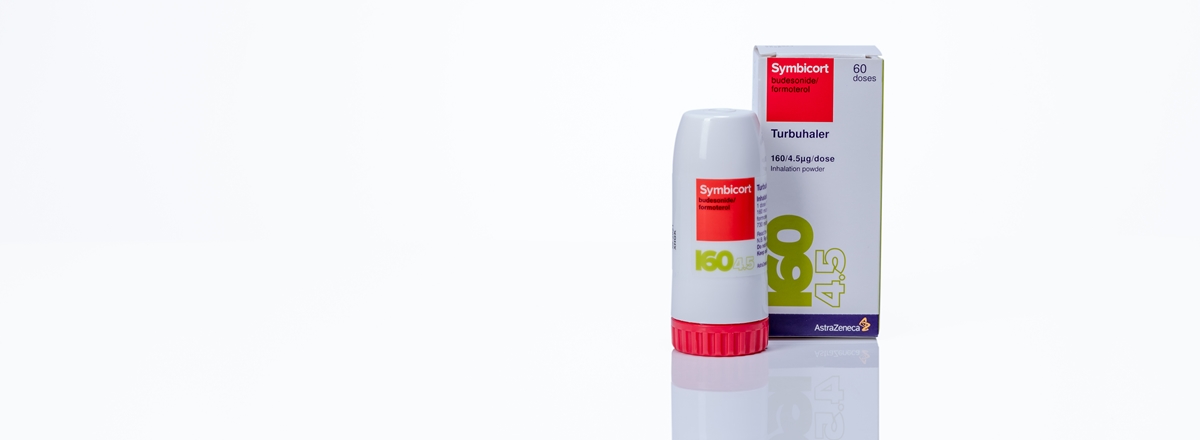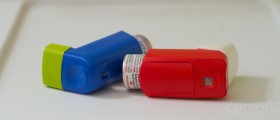Symbicort turbuhaler is made up of two active ingredients: budesonide, a synthetic corticosteroid used to decrease inflammation in the lungs, and formoterol fumarate, a medicine called a long-acting beta 2 against or bronchodilator, as it relaxes the muscles in the lungs allowing the airways to open.
People suffering from asthma, or another chronic obstructive airway disease like chronic bronchitis, have difficulties in breathing because the airways in their lungs tighten due to the accumulation of mucus produced by the constant inflammation of the passageways.
How Does Symbicort Inhaler Work?
The Symbicort inhaler works by decreasing the inflammation and therefore halting the production of mucus, and then relaxing the airways to enable easier breathing. It remains in the organism for the next 12 hours. Because it is inhaled and it reduces any possible side effects to other parts of the body and the amount absorbed into the bloodstream is very low.

Symbicort does not need coordinated breathing and pressing of the canister, but rather only breathing in from the inhaler and the medicine will be absorbed by the lungs. The only important thing is to breathe in forcefully and deeply to inhale most of the medicine.
- We describe the case of a woman with poorly controlled severe asthma after a permanent tracheostomy. She had developed thyroid cancer with tracheal invasion for which right thyroid lobectomy and tracheal and esophageal resection were performed, with subsequent construction of a permanent tracheostomy.
- In our case, prior to surgery, asthma control had been improved by adding a bronchodilator—the long-acting muscarinic antagonist tiotropium—and the anti-IgE antibody agent omalizumab to single maintenance and reliever therapy (SMART) using Symbicort; surgery was then performed. After surgery, asthma control worsened as a result of a change from Symbicort to budesonide nebulizer and a tulobuterol patch.
- In order to resume SMART therapy, an In-Check® inspiratory flow meter was used to measure and assess whether the inspiratory flow rate was sufficient for a dry-powder inhaler. Inhalation guidance was provided. On inhalation with the tracheostomy closed at the same time, the inspiratory flow rate was 43 L/min at the maximum.
- This was judged to be sufficient for the effect of Symbicort, and thus the inhaler was changed to Symbicort. Asthma symptoms promptly improved, and the patient was subsequently discharged.
Most Common Side Effects Of Symbicort Inhaler
There are certain side effects connected with this medication, but their occurrence is very individual and affects different people in different ways. A list of common side effects includes awareness of your heartbeat, headaches, shaking, throat irritation and hoarseness, and sometimes yeast infection of the mouth and throat.
The uncommon side effects include increased heart rate, dizziness, feeling sick, muscle cramps, agitation and nervousness, disturbed sleep, and sometimes bruises.
There are also rare and very rare side effects. The rare side effects include irregular heartbeats, decreased levels of potassium in the bloodstream, wheezing, difficulty breathing, allergic reactions like rashes, itching, swelling of the tongue and throat, or anaphylactic reactions.
The very rare side effects are: changes in blood pressure, depression, disturbances of behavior in children, high blood sugar levels, taste disturbances, chest pains, and some systemic effects like Cushing's syndrome, suppression of the adrenal glands, slowed growth in children and adolescents and so on.
Final Notes
Before prescribing this medication, your doctor needs to know if you are taking any other medication which could interfere with Symbicort.
Beta-blockers should not be used with this medicine as they narrow breathing passageways. It should also not be used with other beta 2 agonists, oral corticosteroids, diuretics, or xanthine derivates. Some medicines interfere with the heart rate so they should not be used with this medicine, and those are atomoxetine, some antihistamines, medicines for abnormal heartbeats, and some antidepressants.

















Your thoughts on this
Loading...